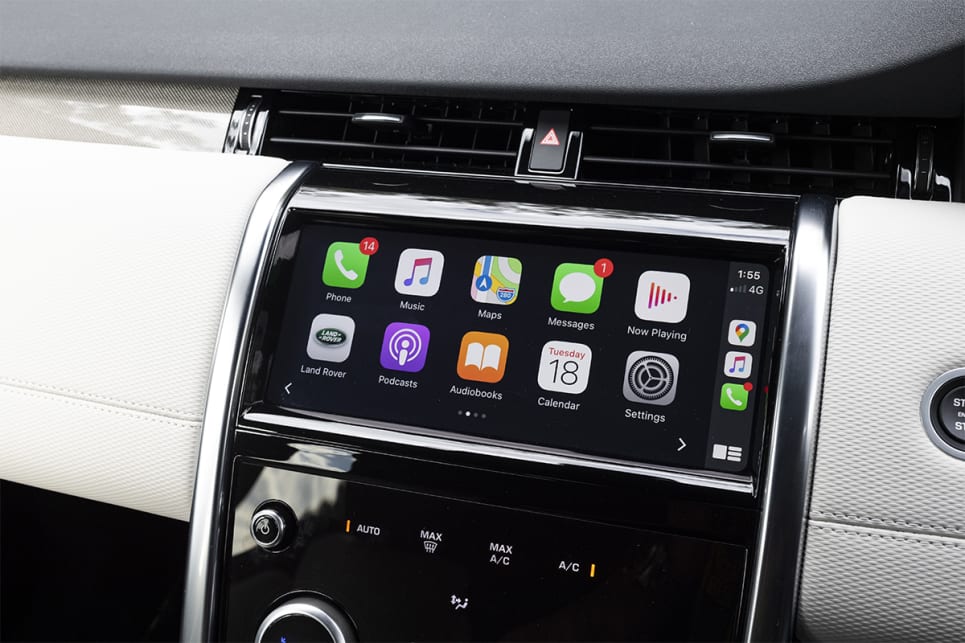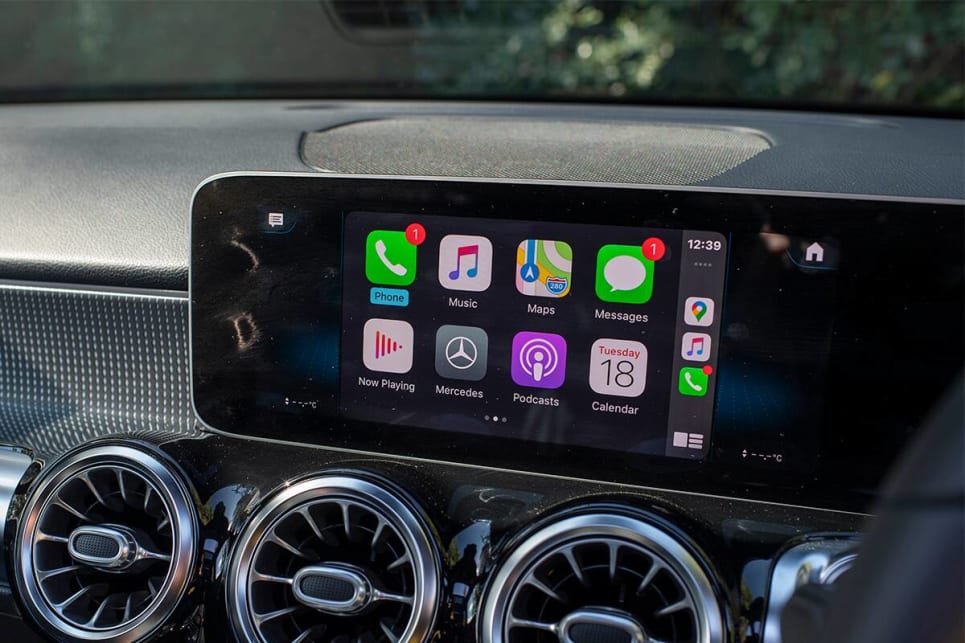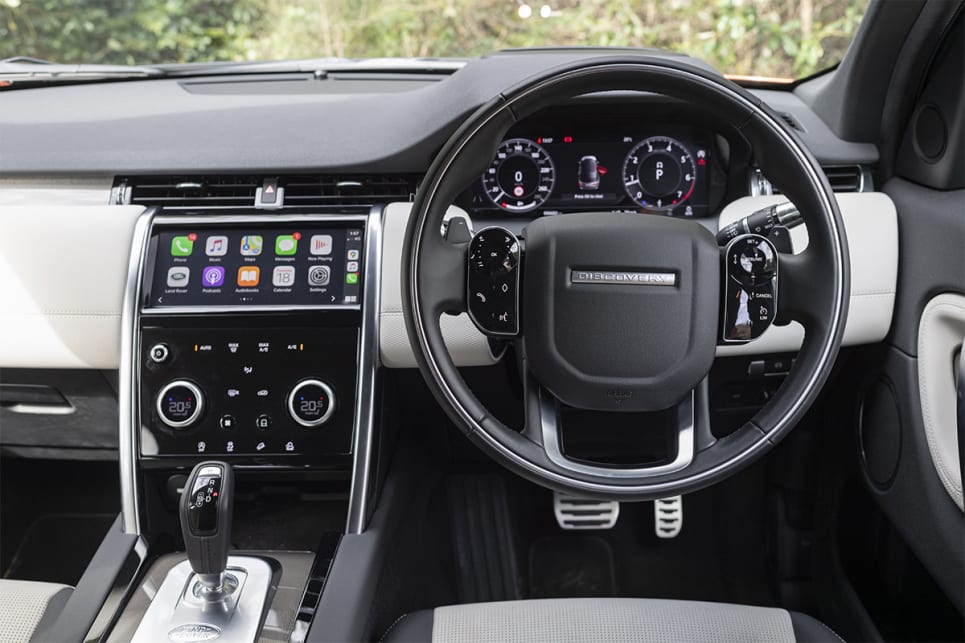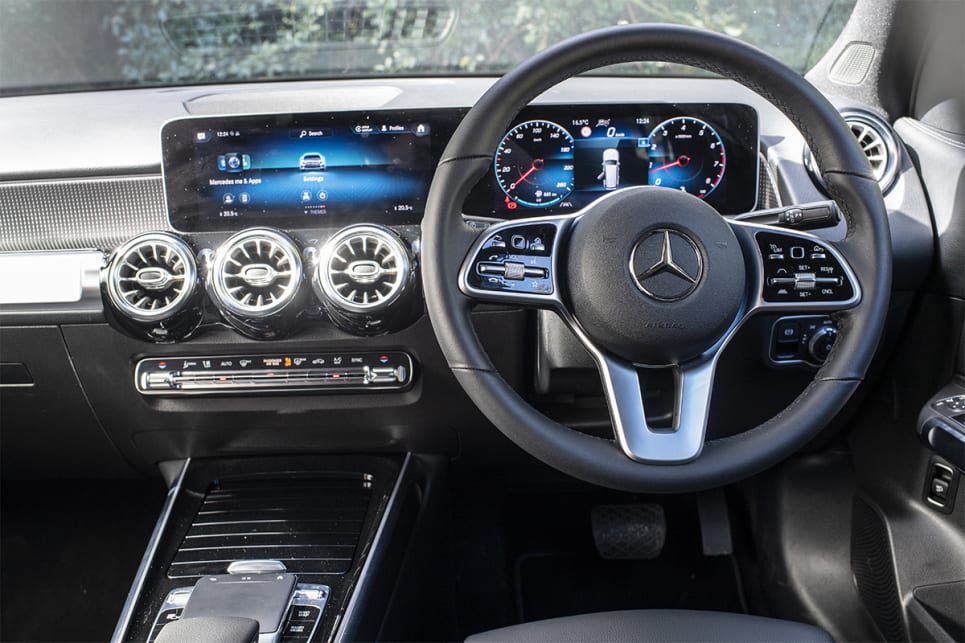Right from the get-go, these two are incredibly evenly matched. Both are smallish SUVs, both have turbo-petrol 2.0-litre engines with all-wheel drive, and both have seven seats.
Despite notably different approaches to design, their prices are closely matched, too.
Each car wears a before on-roads (MSRP) of less than $75,000, although both cars tested here exceed that number thanks to extensive options lists.
Scroll to the bottom of this section to see a full breakdown of the features available on the base cars, and the features fitted to our test cars.
The Discovery Sport P250 SE is the cheaper of the two when it comes to base MSRP, starting from $71,232, although it ended up overshooting the GLB with its lavish options.
The Disco on this test came to a slightly eye-watering $82,312 which is $10k over its start price.
The GLB 250 meanwhile, starts a little higher than its rival here, with a base MSRP of $73,900. Although its reasonably priced and packaged options land the car we tested at just $78,570.
While this seems to give an easy win to the Merc, keep in mind you might not want half the options fitted to our Discovery Sport, with notably expensive items like DAB+ digital radio ($400) not only being standard on the Benz, but hardly worthwhile in many large cities where digital radio coverage can be average at best.
In fact, if you take away our Discovery's optional DAB radio ($400), privacy glass ($650), black contrast roof ($920), and choose 'Fuji White' as your colour ('Namib Orange' on our test car is a $2020 option... ) the Discovery comes down to a much more evenly matched $78,322.
While the Discovery Sport's options list is exceptionally long, it's worth noting that it does have some nifty additions like the 'Clear Sight' camera-based rear vision mirror which can't be fitted to the GLB.
As tested both cars had packs fitted (see table below). Our GLB 250 had the 'Driving Assistance Package' ($1990) including distance control, active lane change assist, cross traffic alert, as well as the 'Vision Package' ($1190) including adaptive high beam plus, multibeam LED headlights, and 360-degree camera suite. Meanwhile the Discovery Sport had the 'Technology Pack' ($1640), Black Exterior Pack ($1590) as well as six other individually-priced options.
When it comes to standard inclusions, both cars impress.
| Mercedes-Benz GLB 250 4MATIC | Land Rover Discovery Sport P250 SE |
Multimedia touchscreen size | 10.25-inch | 10.0-inch |
Apple CarPlay/Android Auto | Y | Y |
Built-in Navigation | Y | Y |
Digital instrument cluster | Y | Y |
Holographic HUD | N (can be optioned) | Y (Part of ‘Tech Pack’) |
SIM capable | Y | Y |
USB ports | 3x USB C front, 2x USB-C middle, 2x USB-C rear | 2x USB 2.0 front |
12v outlets | 1x front | 2x front, 1x middle, 1x rear |
Radio | AM/FM/DAB+ | AM/FM/(DAB+ optional) |
CD Player | N | N |
Sound system | Nine speakers | 10 speaker (190W) |
Wireless Phone charging (Qi) | Y | Y (Part of ‘Tech Pack’) |
How about interior convenience features?No red flags there, and stellar standard equipment overall for both cars although you'll note some items are optional on the Discovery Sport. While neither car had an optional stereo fitted, the Benz's standard audio system sounded clearer and deeper than the Land Rover's.
| Mercedes-Benz GLB250 4MATIC | Land Rover Discovery Sport P250 SE |
Sunroof | Y | N (can be optioned) |
Interior trim | ‘Artico’ black faux leather | ‘Luxtec’ faux leather/suede. Two-tone finish a no cost option |
Front seat adjust | Electric | 12-way electric |
Heated seats | Y | Y ($810 option) |
Cooled seats | N (can be optioned) | N (can be optioned) |
Heated wheel | N | N (can be optioned) |
Air conditioning | Dual-zone climate | Dual-zone climate |
Directional vents in other rows | Second row | Second row, third row ($350 option) |
Keyless entry | Y | Y ($900 option) |
Push-start ignition | Y | Y |
Cruise control | Adaptive (part of Driver Assist Pack) | Adaptive |
Finally, here are some spec differences you'll want to be aware of. Keep in mind we'll cover off what's standard and optional when it comes to safety later in this review.
| Mercedes-Benz GLB250 4MATIC | Land Rover Discovery Sport P250 SE |
No-cost colours | Black | White, Black |
Optional colours | Black (metallic), White x2, Silver, Blue x2, Grey, Red | Black (metallic) White (metallic), Grey x2, Silver x2, Blue x2, Orange, Red |
LED headlights | Y (premium auto-dimming part of ‘Vision Package’) | Y |
Ambient interior lighting | Y | N (can be optioned) |
Parking cameras | 360-degree with see-through bonnet (part of ‘Vision Package’) | 360-degree with see-through bonnet ($500 option) |
Motorised tailgate | Y | Y |
Spare wheel | N (run flats only) | Y (space-saver) |
Do we have a winner here? The Mercedes is slightly more generous with its standard inclusions, and most optional items are in well-priced packs in comparison to the Land Rover which has a frustrating tendency to separate out small items individually.
Mercedes-Benz GLB 4MATIC | Land Rover Discovery Sport P250 SE |
8 | 7 |











































 Lexus NX250
Lexus NX250